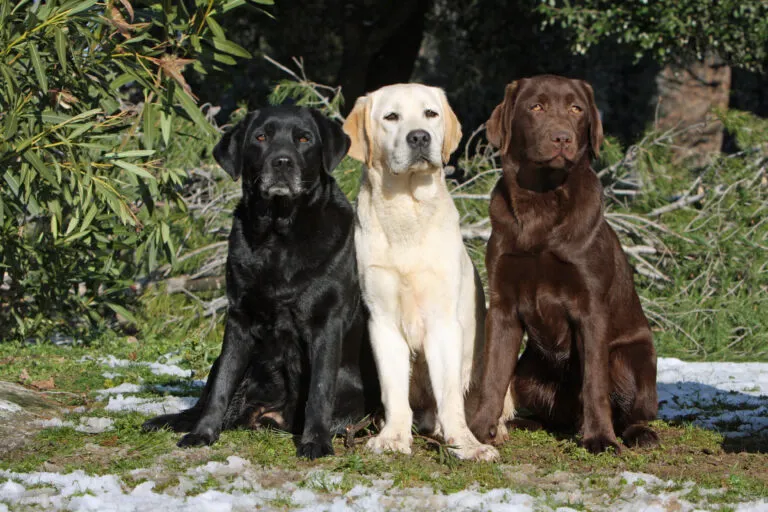Medium Size Poodle
Obedient, fond of people and resilient, the medium-sized Labrador Retriever is an extremely popular family dog, though it likes to be mentally and physically stimulated too as an original working dog.

© Dogs / stock.adobe.com
Black, gold and brown are typical colours for the Labrador Retriever breed.
The Labrador Retriever is one of the most popular pedigree dogs in Britain and the US, though it tops puppy statistics in many European countries too. It’s hardly surprising, since the Labrador Retriever has fondness of people and strong will to please. They are very obedient companion dogs characterised by their willingness to cooperate and adaptability. Labrador Retrievers can be taken everywhere without problems and are well-received guests wherever they go. They always approach strangers in a friendly manner with a wagging tail. These friendly and open dogs are curious and happiest in company. Shyness, fear, uncertainty and aggression are alien to sociable Labradors.
| Feature | Description |
| Breed Type | Medium-sized, strong dog |
| Breeding Lines | Show line, Field-trial line |
| Height (Female) | 21.3-22 inches (54-56 cm) |
| Height (Male) | 22-22.5 inches (56-57 cm) |
| Weight | 55-80 pounds (25-36 kg) |
| Average Lifespan | 12 years |
| Temperament | Affectionate, happy, active |
| Color | Yellow, Black, Chocolate |
| Origin | Great Britain |
| UK Price | Around 1,200 pounds |
You’ll find the suggested products in the video under the following links:
Royal Canin Labrador Retriever Adult (Dry Food), Concept for Life Labrador Retriever (Dry Food), TPR Rope Dog Toy, Dog Bed Fern, Trixie Double-sided Oval Pet Brush
Labradors love their family, especially children, more than anything. Labrador Retrievers love being part of the action. Patient and even-tempered, they are great for family harmony. However, purchasing a Labrador solely for this reason would definitely not do these pedigree dogs justice. Originally bred as hunting dogs, the Retriever is still a very active and eager to work dog characterised by its good sense of smell and immense endurance, as well as its strong love of water and retrieving.
Along with their most popular role as family dogs, versatile Labrador Retrievers are regularly found as guide, rescue and avalanche search dogs, as well as tracking dogs for the police and customs. In order to make a Labrador Retriever happy, you should definitely take into account its urge to work and be active. As an owner, you will soon notice how much more even-tempered and quicker to react your Labrador can be. Mental and pysical stimulation is key.
 © / stock.adobe.com
© / stock.adobe.com
With males reaching a shoulder height of 56 to 57cm and females 54 to 56cm, Labrador Retrievers are a medium-sized dog breed. They are very active with a muscular and strong physique. All in all, the typical Labrador is very compact with a wide head, strong throat and broad, profound rib cage. A characteristic feature is the high-set, powerful “otter’s tail” that tapers at the end and is used by the breed like a rudder in water. The wide head has a pronounced stop, a strong medium-length snout and ears positioned far back and close to the skull.
Another typical feature of the breed if the Labrador’s short, dense fur with a waterproof undercoat. According to the breed standard their fur can be three different colours: black, yellow and brown. The fur is always monotone, though a small white mark on the chest is accepted. Its yellow tone ranges from light cream to fox red, whilst brown Labradors are light to dark chocolate brown. Dominantly inherited black coat is still the most common colour though.
Although only one type is described in the breed standard, two different Labrador lines have developed in breeding over the last few decades. One is the more sturdy Show Retriever and the other the Field Trial Labrador. The latter has a lighter build, predominantly bred for work and has a narrower head, usually with a longer snout. In contrast, the Dual Purpose type should balance the work and show lines and is probably closest to the breed ideal.
The Labrador’s ancestors originate from Canada’s eastern coast, just like the Newfoundland and Landseer. According to reports, the Labrador originates from black water dogs with dense fur known as St John’s dogs. They assisted with hunting or gathering fish and fishing nets that had drifted.
First targeted breeding attempts took place in the second half of the 19th century in England and Scotland after British fishers took these eager dogs home with them. Labrador Retriever refers to the Canadian peninsula Labrador and the dog’s excellent retrieval abilities.
The Labrador breed established itself amongst the hunt-loving English nobility. The second Earl Malmesbury (1778-1841), consistently concentrated on the hunting ability of the animals deployed for breeding. On 7 July 1903, the Labrador was finally officially recognised by the English Kennel Club as an independent dog breed. Several successful exhibitions soon made the active and friendly Labrador well known beyond the nobility and national borders. However, the colours yellow and brown were long considered a breeding defect and only at a later date became accepted and sought alongside the common black fur.
Although the Labrador Retriever is nowadays primarily a family dog, it still has a strong work ethic and retrieval instinct. Most breeders who base their work on the FCI standard concentrate on producing healthy, well-balanced dogs. If you choose a Labrador as a family dog, you shouldn’t forget that it is still a utility dog. It will need a suitable selection of tasks, activities and exercises to complete. Hence, many associations offer training options for Labrador breeders and owners on their practice courses.
Plenty of exercise, activity and meeting its needs generally keeps a Labrador healthy with little cause to fear diseases. Nevertheless, there are a range of hereditary diseases that can only be avoided through controlled and prudent breeding. These predominantly include diseases like hip dysplasia, elbow dysplasia and osteochondrosis. Further, hereditary ocular diseases like progressive retinal atrophy or hereditary cataracts can occur.
When purchasing a Labrador, make sure that that parent animals and puppies are genetically sound. This is the only way to avoid these diseases spreading further. You need to pay a bit more for a well-monitored and vaccinated puppy with all necessary paperwork in order. Hence, the price for a Labrador Retriever is generally around 1,200 pounds. This price should be worth it for a healthy dog.
Once you have purchased a dog, its health is your responsibility. A balanced diet providing your Labrador with all important nutrients and neither too much nor too little energy ensures that it will remain active and healthy for many years. Unfortunately, Labradors in particular tend to overeat. Obesity is very unhealthy for dogs and leads to numerous diseases that can shorten their lives.
Excess fat or even sweeteners like sugar or glucose have no place in your dog’s food bowl. A healthy, balanced diet generally features a high quantity of meat (at least 70%). Vegetables and fruit (around 20-30%) provide important vitamins and nutrients. In contrast, your dog only needs a small amount of grain. A food containing a lot of grain is generally of poor quality.
Also read our articles on appropriate nutrition for Labrador Retrievers and discover our selection of dog food for Labradors in the zooplus store.
It’s important to control the amount and composition of food. Never let your Labrador decide how much to eat. They are quite greedy dogs and would eat much more than is good for them and their stomach. How much food is good for them can vary greatly depending on their age, weight and activity level. One to two meals per day always at the same time are generally enough for Retrievers. If you give your dog occasional treats, you should compensate by giving your dog slightly less food.
There are no prescribed weight tables for Labrador Retrievers. It’s ultimately down to you to judge whether your dog is too fat or too thin. In principle, you should be able to feel the ribs with your hand without being able to see them. If you’re uncertain, you should ask your vet or breeder about the right diet and amount of food.
The right grooming also makes an important contribution to your Labrador’s health. Along with routine veterinary examinations, which you should definitely stick to, you can recognise and treat infections at an early stage with regular short check-ups. You should pay particular attention to your Labrador’s ears, eyes and teeth. In order to avoid injuries or inflammation, trim your dog’s claws regularly. The Labrador’s fur is quite low-maintenance and almost cleans itself. However, it should be thoroughly brushed at least once a week to remove loose hairs and stubborn dirt.
Good grooming doesn’t need to take up a lot of time. Plan time for check-ups and procedures into your daily or weekly schedule so that they become routine. Dogs like rules and good organisation, with too many unexpected surprises and changes confusing sensitive Labradors. Start the grooming routine during puppy phase so your dog gets used to sitting still at an early stage.
Housing and training for Labradors are just as straightforward as grooming. These dogs are ideally suited for first-time owners too. However, there are some basics to bear in mind for owning a Labrador Retriever.
The Labrador is a working and utility dog by nature, therefore needs plenty of exercise and ideally sufficient activity options too in order to be happy and meet its retrieval instinct. A house with its own garden and sufficient space for these active dogs should be a fundamental requirement for owning a Labrador. These dogs require a lot of exercise – a few short walks around the block each day aren’t sufficient. Dog sports like obedience and dog dancing, tracking dog training or hunting tests are suitable in order to mentally and physically stimulate your dog. To make daily walks more varied, you should integrate little search and retrieval games. You will also make these water-loving athletes happy by letting them take a dip in a river or lake.
The right training is the cornerstone of the dog-owner relationship. Generally, Labradors make it easy for you with their people-focused nature and will to please. It’s important though that you train these sensitive dogs in a consistent but loving manner. Your dog will react much better to positive reinforcement like praise or an occasional treat than excessive severity. If you’re a first-time owner, send your Lab to dog school. This enables your dog to practise the most important commands and mannerisms.
In principle, the better trained your dog is, the more you will be able to do together – be it bike rides, visiting friends or beach holidays together. Life with a Labrador Retriever is full of variety.
Here are some purchase proposals curated by the zooplus editorial team
The products featured have been carefully selected by our editorial staff and are available at the zooplus online pet shop. The selection does not constitute advertising for the mentioned brands.
Fans of the Bearded Collie agree that those who aren't familiar with this dog breed simply have to get acquainted with it. And those who have experienced how a Bearded Collie bolts across meadows with its flowing fur, how it rolls around full of energy and joy and how it attentively and observantly takes into account its owners wishes become simply addicted to this original dog breed and its unique charm.
The Goldendoodle isn't a breed, but a pairing between Golden Retrievers and Medium or Standard Poodles. Marketed as a low-maintenance dog for allergy sufferers, this hybrid is enjoying increasing popularity amongst dog lovers, similar to the Labradoodle.